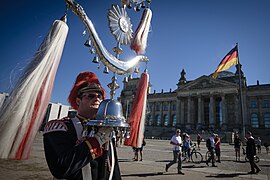Vigilante groups
The Civil Guard quantities is an existing for over 800 years vigilantes . With its four platoons and around 150 members, the Mengening Wehr is one of the three largest vigilante groups in the “State Association of Historic Wehrs and Garden Württemberg and Hohenzollern”. She represents her city at home and abroad as well as at religious and secular festivals. The annual tattoo on the occasion of the Mengening May Festival is of particular importance.
history

In 1257, Mengen was designated a free city in a document; associated with it were probably a fortification and an organized vigilante group. The form of training and the type of armament were regulated by resolutions of the council. One of the council minutes reads: “Every citizen is required to do military service. The citizens are arranged in districts and each district of the city has to provide a squad , which was headed by squad masters ”.
The equipment of the military men consisted of a harness with body protection and balaclava, a halberd or a long spear and sword. The bow and crossbow served as long-range weapons. The citizen had to purchase all weapons at his own expense. It was customary for archery to be practiced regularly, for which there was a large number of a shooting society.
In 1343 this vigilante group suffered a defeat with considerable losses against the army of Count Eberhard den Greiner von Württemberg . Quantities were subsequently stormed and looted. In 1607 the vigilante group was first equipped with firearms - with muskets - and a shooting house was set up. During the Thirty Years' War , the vigilante group was very popular, as joining the vigilante group was also associated with civil rights. On May 18, 1632, the residents of Mengen gathered in prayer to implore the city to be saved from the Swedes - in fact, the gathering fog prevented the attack of the Protestant troops. This event is the basis of the tradition of the May Festival of Crowds.
With the increasing formation of standing armies, the vigilante group increasingly lost its military importance and increasingly concentrated on parade and representation tasks. She received Prince Eugene in 1714 and the Imperial Prelate of Petershausen in 1761. On May 2, 1770, 90 citizens with “rifled hands and schoolchildren with wooden guns” paraded in front of the Austrian imperial daughter Marie Antoinette on her bridal procession from Vienna to Paris .
In 1806, Mengen became part of the Kingdom of Württemberg , and the vigilante group was retained, despite initial rejection by the Württemberg government. Regular participation of the 60 grenadiers of the vigilante group together with their 24-strong "Turkish music" in city celebrations are recorded. The payment of the wages took place on Corpus Christi day. In 1826 the vigilante group received its own flag, at that time the uniform consisted of dark trousers, a blue skirt and white cruciate ribbons as well as a distinctive bearskin hat.
The tradition of the vigilante guard continued in the First and Second World Wars . The vigilante guard moved out with restrictions both during the war years and afterwards on festive occasions. In 1952 there was a new uniform and the installation of a second train based on the historical model from 1820 to 1848. For the home and children's festival in 1952, a children's group ("Small Citizen Guard") was set up for the first time.
The subdivisions of the vigilante guard
Marching band crowds
The Massener miners wear the two-row dark blue Württemberg uniform from 1864/1871, based on the Prussian pattern. The collar, the lugs and the cuffs are red, the fishing line and the swallow nests are red / white. The drummers wear white knees, the "apron". The helmet is a spiked hat with a red bush. On old helmets a golden "M" for quantities is attached, the coat of arms of Württemberg is on the new helmets.
Music train (Stadtkapelle Mengen)
A town band was founded between 1800 and 1820. A council minutes from 1821 mentioned “Turkish music”, which was paid for together with the vigilantes for the march. Also for September 27, 1822, King's Day, a move out of the civil guard with the "Janissaries" is documented. Like the marching band, the musicians now wear the Württemberg tunic, but with golden swallow nests and lanyards. Initially, the musicians also wore the spiked bonnet, and after the Second World War a “cap” with a red horse tail. The conductor wears an officer's uniform with a bush of white hair on his cap.
Grenadiers of the first platoon
The grenadiers of the 1st platoon with the dark blue tunic of the Württemberger around 1864/1871 with shoulder sleeves carry a Swiss breech-loading rifle, Schmitt / Rubin system model 1896/1871, on a white belt a side rifle that can be attached to the rifle. The lanyard is red / black. The helmet is a spiked hat with a black bush of hair.
Grenadiers of the second platoon
In 1952 a second train was set up based on the historical model from 1820/1848. The light blue Kolettrock has two rows of buttons, red lap folds and red cuffs and gold-colored epaulettes. On the second move, a brown fur hat is worn instead of the pimple hat. The white pants end in short white gaiters. Instead of a belt, the grenadier wears two crossed straps, one for the cartridges and the other for the short saber. The lap envelopes and the white trousers with gaiters give the uniform a French character. As armament, the grenadiers carry a percussion front loading rifle model 1777 with caliber 0.69.
Captain
The captain is in command of the Quantities vigilante guard. He wears a white helmet plume, wears his service badge on his epaulettes and on his sleeve, wears a field bandage and always wears his saber drawn in the formation.
Captains of the vigilante group since 1828:
- 1828 Bolter, Alois
- 1837 Jutz, Lorenz
- 1848 Sigrist, Ph. Jacob
- 1876 Jung, Martin
- 1901 Keßler, Raymund
- 1911 Blank, Karl
- 1951 Bosch, Karl
- 1954 Mannhart, August
- 1962 Keßler, Erwin
- 1980 Schröter, Willi
- 1990 Kieferle, Josef
- Since 1999 Bacher, Georg (since 2015 Major (Deputy State Commander))
Parades, roll calls and the great tattoo
In their home town of Mengen, the vigilante guard usually moves out five times a year: in January on their anniversary, on May Day, on Corpus Christi, depending on the rhythm at a city festival (Heimattage, Fuhrmannstag, Mengen International) and on national mourning day. State representational tasks are also part of the task: For example, the Wehr paraded in front of the New Palace in Stuttgart on the state visit of Soviet President Mikhail Gorbachev in 1989.
National and international appearances
In 2013, the vigilantes carried out an appeal for Cardinal Walter Kasper and for the ambassador of the German Embassy Martina Nibbeling-Wrießnig on the Piazza Navona in Rome ; the music procession gave a concert on the Capitol together with the fanfare of the Carabiniers. The vigilante guard also framed services in both German parishes in Rome, initially with Cardinal Walter Kasper in the “Anima” and with the rector of the priestly college at Campo Santo Teutonico, Dr. Hans-Peter Fischer, in “Santa Maria della Pietá”. After the mass there was a memorial of the dead in the German cemetery in the Vatican and a march into St. Peter's Square for the blessing of Pope Francis .
On the occasion of the Bavarian state exhibition "Napoleon in Bavaria", the vigilante guard was a guest in the old garrison and fortress town of Ingolstadt in 2015 , performed the big tattoo on Paradeplatz and helped to organize the festive service in Marienmünster.
At the invitation of Thomas Bareiß , the Bürgerwache appeared in public in Berlin in 2016. Welcome roll calls were held on Potsdamer Platz and in the Baden-Württemberg State Representation in Tiergartenstrasse. The next day - on the 175th anniversary of the Deutschlandlied - the company marched from the Federal President's office along the bank of the Spree past the Chancellery to the Reichstag building to play the national anthem
The city of Mengen maintains close ties to France. After the Second World War, the mayor Hermann Zepf sought a city partnership with Boulay-Moselle immediately after signing the Élysée Treaty . The Ambassador of France, Philippe Étienne , paid tribute to this partnership on Pariser Platz during an appeal in front of the Brandenburg Gate. In the Lustgarten, interior senator Frank Henkel received the vigilante guard on behalf of the city of Berlin . The town band gave an hourly concert on the Gendarmenmarkt . The trip ended with a thanksgiving service in the former soldiers and invalids church of St. Sebastian with the vicar general of the Bundeswehr, Reinhold Bartmann, and the deans Heinz Leuze and Bernd Schaller.
On the occasion of the 300th anniversary of the celebrations for the princely wedding of 1719, the civil guard traveled to Dresden for four days in 2019 under the patronage of the city and the state parliament. Appeals were held in front of the town hall, on the Altmarkt and Neumarkt , in front of the Fürstenzug and the Golden Rider, as well as concerts in front of the Semperoper and on the Brühl terrace . At dusk on Saturday, August 31, 2019, the Great Zapfenstreich was performed in the Zwinger , on Sundays the music procession helped shape the chapter office in the Hofkirche, which Vicar General Andreas Kutschke celebrated.
Big tattoo
Traditionally, the vigilante guard performs the big tattoo in large quantities on the occasion of the May festival.
Sponsorships
- Saulgau vigilante guard
- City guard on horseback Saulgau
- Civil Guard Friedrichshafen
- Rifle company Neustift in Tyrol
- Schlanders, Göflan and Kortsch rifle companies in South Tyrol
Web links
- Website of the vigilante group
- Website of the regional association of historical vigilante groups and Stadtgarden Württemberg-Hohenzollern
Individual evidence
- Bacher, Urban: Deutsche Marschmusik, Konstanz 2013 , 2nd edition, Konstanz 2019.
- Stehle, Anton: Bürgerwache Mengen, Festschrift, Mengen 1997











